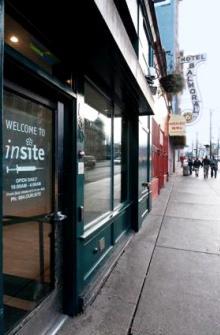Ottawa’s mayor and police chief say they will not support safe injection sites, despite a recent survey showing the majority of Lowertown residents favour the creation of a monitored site for injection drug users.
“This is a health crisis that has been going on for far too long,” says Christopher Dalton, coordinator of the Campaign for Safer Consumption Sites in Ottawa (CSCS), which commissioned the six-question survey in late April.
“Unfortunately people are dying in the streets, overdose deaths are at least three a month and HIV rates are rising,” Dalton says. “People are dying from something that could be prevented.”
Based on data it compiled from the Canadian AIDS Society, the Sandy Hill Community Centre and a 2012 report on safe consumption sites in Ottawa and Toronto, CSCS claims creating a safe consumption site in Ottawa would save $3.2 million in healthcare costs and prevent 10 new HIV infections per year.
But Mayor Jim Watson’s press secretary, Ryan Kennery, tells Xtra that the mayor supports Police Chief Charles Bordeleau’s position that priority should be placed on prevention programs.
“Mayor Watson is proud of what the City and community leaders are doing in establishing the youth drug treatment centres in the east and west ends. Using scarce public health dollars for these drug treatment centres will continue to be his focus when it comes to helping young people addicted to drugs,” reads the statement that Kennery sent Xtra.
Caleb Chepesiuk, manager of education and prevention at the AIDS Committee of Ottawa, says a safe consumption site in Ottawa is overdue and “it’s unfortunate to see such resistance to a public health measure from the mayor.”
Fear and misinformation are common factors when it comes to resistance to changing drug policies, Chepesiuk says.
“It’s not looked at on the merits of the program. Instead, opponents discuss it in distorted ways. If you stick to the evidence of it, if you stick to the concept of respecting and upholding the dignity of the people who use drugs, harm reduction services make sense when they are pieces of more comprehensive strategies which address substance use,” Chepesiuk says.
If the City will not support the project, the province could step in, as it did to rescue the scrapped, city-run crack pipe program in 2007, Chepesiuk points out.
Ontario Minister of Health Deb Matthews’ office did not return a request for comment.
Ottawa claims the highest increase in HIV cases among intravenous drug users in the country and this is not something our city should be proud of, says Simone Thibault, executive director of the Centretown Community Health Centre (CCHC).
“We need to be a caring society and be there for . . . [drug users.] We need to look at different avenues. When you look at different options for people who are really at the end of their rope, we need to look at many options,” Thibault says. “It’s not easy to go into treatment. You have to connect with people at where they are at.”
Thibault commends CSCS for conducting the survey and says representatives from CCHC, Somerset West Community Health Centre and Sandy Hill Community Health Centre have no immediate plans to open a site but are examining the prospect.
For the project to come to fruition, the Supreme Court of Canada must grant an exemption to the Controlled Drug and Substances Act.
Vancouver’s Insite, a safe consumption site run by Vancouver Coastal Health, was granted an exemption and has operated since 2003.
In 2011, the Conservative government challenged Insite’s operations but the Supreme Court ruled against the Conservatives by a vote of 9-0.
Anna Marie D’Angelo, senior media relations officer with Vancouver Coastal Health, says since Insite’s inception, British Columbia went from having the highest rate of HIV infection – “that rivalled third world countries” – to the lowest rate in the Canada.
However, there was one major difference that allowed Insite to become a reality: BC politicians supported the creation of a safe consumption site, unlike here in Ottawa.
D’Angelo says for most Canadians, this is a “black and white issue.”
“We look at it through a health care lens and not a policing lens,” D’Angelo says. “Harm reduction is a way to get people off of whatever drug they are on.”
D’Angelo adds that just because a safe consumption site works in Vancouver, doesn’t mean it will work for Ottawa.
“In the Downtown Eastside of Vancouver there’s a concentrated number of long-term injection drug users. That’s a unique situation in Vancouver. You have to figure out if it’s going to work for you,” D’Angelo says.
Thibault says if a proper structure and adequate support are in place, a safe consumption site will work in Ottawa.
“I’m hopeful that the city, province and others start hearing from the community that this is important to them. The evidence is there. We can ignore problems or we can address them in a constructive way,” Thibault says. “For far too long we’ve addressed addiction through the court system instead of through the health system, which I think it’s where it needs to be.”
Ottawa’s chief medical officer, Dr Vera Etches, could not be reached for comment.


 Why you can trust Xtra
Why you can trust Xtra


